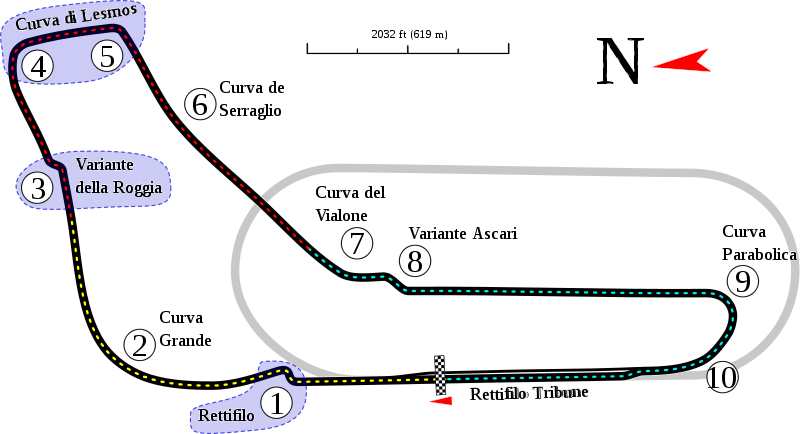


This was the last world championship event at the track until the World Touring Car Championship visited this year for a pair of three-lap races.

Seven years later the World Endurance Championship also said farewell to the ‘Ring. Niki Lauda’s fiery crash in the subsequent race, which almost cost him his life, served to underline that point.
Monza trackmap drivers#
However the difficulties of providing adequate marshalling for such a long track remained a problem, and ahead of the 1976 race the drivers were determined not to return to the track again. This was completed and the Nurburgring regained its place as Germany’s world championship venue from 1971. In 1970 the GPDA flexed its muscles and refused to race at the Nurburgring until a substantial barrier-building programme had been undertaken. However the Nurburgring became a target for the Grand Prix Drivers Association’s demands for safer circuits. Ringmaster John Surtees won twice on the NordschleifeBuilt under the Weimar government of the 1920s (not, as is often falsely recorded, the subsequent era of Nazi rule), it regularly held grands prix into the world championship era. Permanent road course: 22.835km (1967-76 version)Ĭonsidered the greatest and most challenging circuit ever devised, the original Nurburgring – infamously nicknamed the “Green Hell” by Jackie Stewart – was a 160-turn behemoth that wound its way through the Eiffel Mountains of western Germany. That the fastest lap, set by race winner Stirling Moss, was almost ten minutes long shows what a colossal track this was. Pescara first staged races in 1924 and held its sole world championship grand prix in 1957, documented in Richard Williams’ superb book The Last Road Race. It was split roughly into two sections – a long, twisty first half followed by two six-kilometre straights to complete the lap. The circuit took in the undulating Italian countryside in a triangle between the towns of Pescara, Cappelle and Montesilvano. The Pescara circuit on Italy’s Adriatic coast was one such venue: three-and-a-half times the size of the longest track on the calendar today, Spa-Francorchamps. But the early years of the world championship continued to feature scaled-down versions of the old super-tracks. Some of these courses were monsters measuring in excess of 100 kilometres taking in several towns.Īs the world championship began in 1950, closed road tracks were increasingly bring replaced by shorter, permanent venues such as Monza, Silverstone and Indianapolis. Pescara, Italyīefore anyone thought to build tracks to race cars on, grand prix racing originally took place on public roads. And it also means that the following ten circuits are unlikely to be surpassed as the longest in F1 history. Given the costs involved in building long race tracks, and the difficulties of properly managing them, it is perhaps understandable that the FIA now recommends new circuits to be no longer than 7km.

For the first few decades of the world championship, before the FIA’s notion of maximum circuit length had been born, Grand Prix’s regularly took place on circuits far longer than we see today. Almost all of them have between 15 and 20 corners, minimal elevation change, similar average speeds, and almost entirely made up of slow corners.īut it was not always this way. Of F1’s current venues, all but Monaco and Spa are between 4.3km and 5.9km long. The creeping Tilke-isation of the calendar means race tracks increasingly resemble each other in length, corner numbers and character. By the standards of past circuits, the Formula One tracks of the 21st century are a homogeneous bunch.


 0 kommentar(er)
0 kommentar(er)
